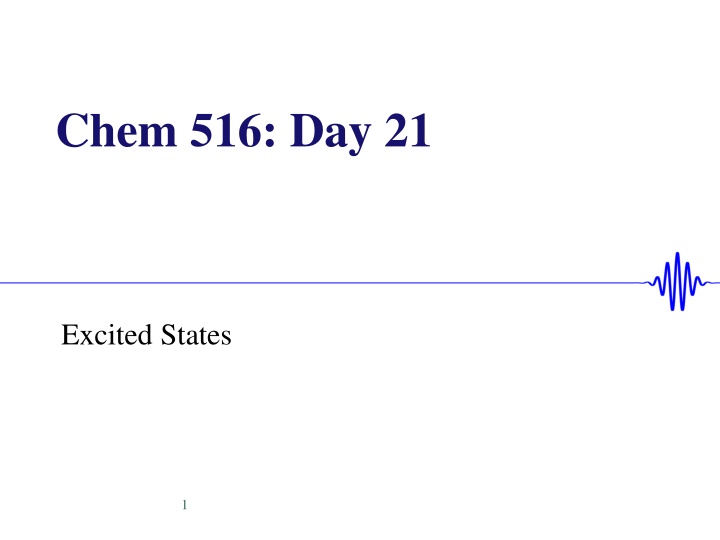
Photochemical Processes in Molecules: Excited States and Relaxation
Dive into the world of photochemistry by exploring how molecules behave after absorbing light, different relaxation mechanisms, spectral widths, and calculating quantum yield. Discover the photochemical processes of Fe(bpy)32+, and how Jablonski diagrams help visualize energy transitions. Learn about vibrational relaxation and potential energy surfaces, while understanding timescales of these processes. Explore the meaning of timescales, lifetime, and absorption of light colors in molecular systems.
Download Presentation

Please find below an Image/Link to download the presentation.
The content on the website is provided AS IS for your information and personal use only. It may not be sold, licensed, or shared on other websites without obtaining consent from the author. If you encounter any issues during the download, it is possible that the publisher has removed the file from their server.
You are allowed to download the files provided on this website for personal or commercial use, subject to the condition that they are used lawfully. All files are the property of their respective owners.
The content on the website is provided AS IS for your information and personal use only. It may not be sold, licensed, or shared on other websites without obtaining consent from the author.
E N D
Presentation Transcript
Chem 516: Day 21 Excited States 1
Goals for today Understand what happens to a molecule after it absorbs visible light Know the different types of relaxation Understand why spectra have finite widths Learn to calculate quantum yield of a photochemical process 2
Lets look at the photochemistry of Fe(bpy)32+ Bpy * Fe eg Fe t2g 3MLCT 3MC 5MC (5T2g) 1MLCT Ground State (GS) (3T1g or 3T2g) 3
We can redraw this with a Jablonski Diagram Intersystem Crossing (ISC) 3 1MLCT 3MLCT Internal Conversion (IC) 2 Energy (eV) 3T1g IC ISC 3T2g 5T2g Fluorescence 1 Phosphorescence 0 1GS 4 Vertical axis is energy, horizontal is usually spin (but not always)
Can also include vibrational levels Intramolecular Vibrational Relaxation (IVR/VR) 3 1MLCT 3MLCT 2 Energy (eV) 3T1g 3T2g 5T2g 1 0 1GS 5
Sometimes the potential energy surfaces are drawn as well 6 10.1126/science.1165733
We would like to measure timescales for all these processes 3 30 fs 1MLCT 3MLCT 170 fs 2 Energy (eV) 3T1g 50 fs 3T2g 5T2g 2 ns 1 2 s 0 1GS 7 Italicized ones are my estimates, since they can t actually be measured
What do these timescales actually mean? 1.0 ?? ? 0.8 e(-t/20) ?[?] ?? = ?[?] 0.6 [A] 0.4 ? = ?? ?? = ?? 1/e=.37 ? 0.2 .13 0.0 = 1/? 0 20 40 60 80 100 Time Lifetime = 1/ Rate constant 8
Lifetimes are also related to linewidths C The question: what color light gets absorbed? Probe B If State B only lives for 1 fs, and your photon has a period of 2.6 fs (1.5 eV), is that enough time to measure it accurately? Pump What if I try doing EPR spectroscopy on that excited state? the period of a 1 cm-1 photon is 33 ps A 9
Time-energy uncertainty E t /2 /2 = 3.3x10-16 eV*s = 0.33 eV*fs = 2.6 cm-1*ps Method IR EPR UV/Vis X-ray Mossbauer E 3000 cm-1 1 cm-1 25,000 cm-1 10,000 eV 14,400 keV E 1 cm-1 .001 cm-1 100 cm-1 1 eV 10-9 eV t 2.6 ps 2.6 ns 26 fs .33 fs 330 ns 10
There is also a different broadening factor (Lorentzian) (Gaussian) O H H molecule H H molecule O O H H 11
OK, back to photochemistry. We can measure the excited state dynamics using transient absorption Probe beam CCD array Diffraction grating Sample Pump beam 0.25 0.25 Excited states 0.20 0.20 Absorbance Absorbance 0.15 0.15 - = D DA 0.10 0.10 0 0.05 0.05 Loss of ground state 0.00 0.00 55 60 65 70 55 60 65 70 55 60 65 70 12 Energy (eV) Energy (eV) Energy (eV)
Two ways to get the time axis For fs to ~12 ns, use a delay line: 1 m round-trip = 6 ns For ~10 ns to ms, fast electronics to control either the CCD or the delay of the probe pulse 13
Other ways to get ms to seconds time resolution A fun technique from the Denmark lab: Rapid-Injection NMR: J. Org. Chem., 2010, 75, 5558 The instrument has been designed to provide universal application for the real time analysis of fast chemical reactions. The authors urge interested parties to not embark on the construction of their own instrument and invite those whose research problems might be amenable to this kind of analysis to contact the corresponding author for access to the apparatus described herein. 14
Lets bring this back to reactivity with photoredox chemistry 15
Easier to see with a Jablonski diagram Ru(bpy)32+* + R2X + R3N: kquench Ru(bpy)31+ + R2X + R3N+ kSingleElectronTransfer kphos Ru(bpy)32+ + R2 + R3N+ kChargeRecombination ?? ???? ???+???? Quantum Yield = Ru(bpy)32+ + R2X + R3N: ?? +?? 16
Final group activity: with these s, what is ? Ru(bpy)32+* + R2X + R3N: q=200 ns Ru(bpy)31+ + R2X + R3N+ SET = 20 s ph=1 s Ru(bpy)32+ + R2 + R3N+ CR = 10 s ?? ???? ???+???? Quantum Yield = Ru(bpy)32+ + R2X + R3N: ?? +?? 17 83% x 22% = 28%
